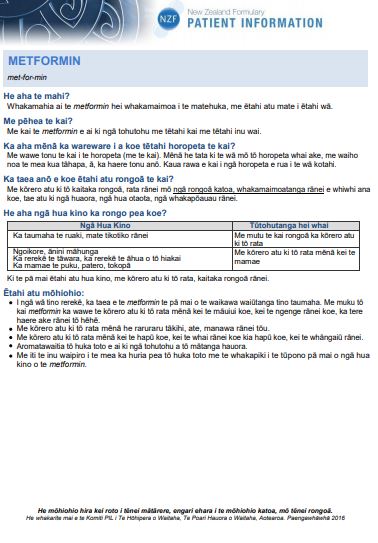Metformin is a tablet commonly used for people with diabetes, but it can also help to reduce some symptoms of polycystic ovary syndrome (PCOS). It helps your body make better use of the insulin it produces and can help with weight loss and blood pressure. Metformin may help to restore your menstrual cycle, as well as helping control excess body hair caused by high testosterone levels. Read more about PCOS and how it's treated.
Metformin is licensed in Aotearoa New Zealand for treating type 2 diabetes. However it doesn't have a license for use in PCOS, so when it's used in this way it's described as ‘off-label’. Metformin has been used in PCOS for several decades. Read more about what 'off-label' means.
Low or no data? Visit Zero Data then search for 'Healthify'. Click on our logo to return to our site and browse for free.
Metformin for polycystic ovary syndrome (PCOS)
Key points about metformin for PCOS
- Metformin is used to treat polycystic ovary syndrome (PCOS).
- Metformin helps your body make better use of the insulin it produces, and can help with weight loss and reduce the chance of developing diabetes.
- Active lifestyle management (healthy diet and physical activity) has similar benefits to metformin.
- Find out how to take it safely and possible side effects.

Active lifestyle management (a healthy diet and physical activity) and the combined oral contraceptive pill (“the pill”) are usually recommended before metformin. These are called first-line treatments.
The combined oral contraceptive pill is used to help with irregular menstrual periods and hyperandrogenism (eg, high levels of testosterone, excess facial or body hair).
Metformin is a second-line treatment, used when lifestyle and the oral contraceptive pill haven't been successful.
Lifestyle management and metformin are similar in their benefits. Metformin should be used together with active lifestyle management, not as a replacement.
Metformin can also be used for treating infertility in PCOS. Metformin can be used with clomifene citrate (a medication that helps the growth and release of a mature egg) or alone.
Metformin is recommended for adults with PCOS and a BMI ≥ 25 kg/m2, to help achieve weight goals and help with insulin resistance, glucose levels, and lipid profiles.
In Aotearoa New Zealand metformin is available as tablets (500 mg and 850 mg).
- The starting dose for adults with PCOS is 500 mg once a day.
- Your doctor will increase your dose slowly over a few weeks. This allows your body to get used to the medicine and reduces side effects.
- The usual dose is 1500 to 1700 mg per day.
- The suggested maximum daily dose for taking metformin for PCOS is 2.5 g in adults and 2 g in adolescents.
- Always take your metformin exactly as your doctor has told you. The pharmacy label on your medicine will tell you how much metformin to take, how often to take it and any special instructions.
- Food: Always take metformin with food – during a meal or just after a meal. This helps to reduce side effects.
- Timing: Each day's tablets are usually divided into 2 doses (breakfast and dinner), or sometimes into 3 doses (breakfast, lunch and dinner). Try to take your metformin dose at the same times each day, to help you remember to take it.
- Missed dose: If you forget to take your dose, take it (with food) as soon as you remember. But if it's nearly time for your next dose, just take the next dose at the right time. Don't take double the dose.
Here are some things to know when you're taking metformin for PCOS. Other things may be important as well, so ask your healthcare provider what you should know about.
Assess whether you need contraception. Be aware that, unlike some other treatments for PCOS, metformin doesn't act as a contraceptive. Sometimes people with PCOS who haven't got pregnant before taking metformin have got pregnant after starting to take it.
If you don't want to get pregnant, and you're thinking about taking metformin to control some of the symptoms of PCOS, you should discuss your contraceptive needs and options with an appropriate healthcare provider.
- Metformin is safe to take long term but you should be monitored and reviewed regularly.
- Read more about what to know while you're taking metformin.
The most commonly reported side effects of metformin are tummy upset including nausea (feeling sick), vomiting (being sick) or diarrhoea (runny poos). Side effects are minimised by:
- starting metformin at a low dose and then gradually increasing the dose over a few weeks
- taking it with a meal.
Although metformin is also used to treat diabetes, unlike other medicines used for diabetes, metformin doesn't cause low blood glucose levels (hypoglycaemia or hypos). Read more about the possible side effects of metformin.
Resources
PCOS treatment(external link) Monash University, Australia
PCOS, fertility and pregnancy(external link) Monash University, Australia
Metformin(external link) SafeRx, Waitematā DHB, NZ
Metformin in te reo Māori(external link) My Medicines, NZ
5 questions to ask about your medications(external link) Health Quality and Safety Commission, NZ, 2019 English(external link), te reo Māori(external link)
References
- Metformin(external link) Medsafe Data Sheet, NZ, 2018
- International evidence-based guideline for the assessment and management of polycystic ovary syndrome 2023 (external link)Monash University, Australia, 2023
Brochures

My Medicines, NZ, 2016

Monash University, Australia

Monash University, Australia
Credits: Healthify He Puna Waiora Pharmacists. Healthify is brought to you by Health Navigator Charitable Trust.
Reviewed by: Dr Melanie Gibson, Senior Research Fellow, Te Tātai Hauora o Hine (National Centre for Women's Health Research Aotearoa), Te Herenga Waka (Victoria University of Wellington), and Monash Centre for Health Research and Implementation, Monash University.
Last reviewed:





